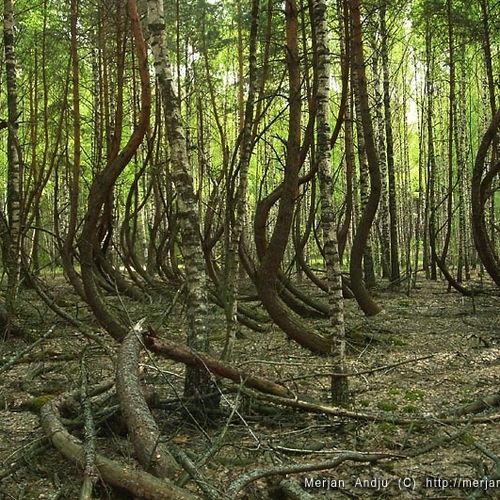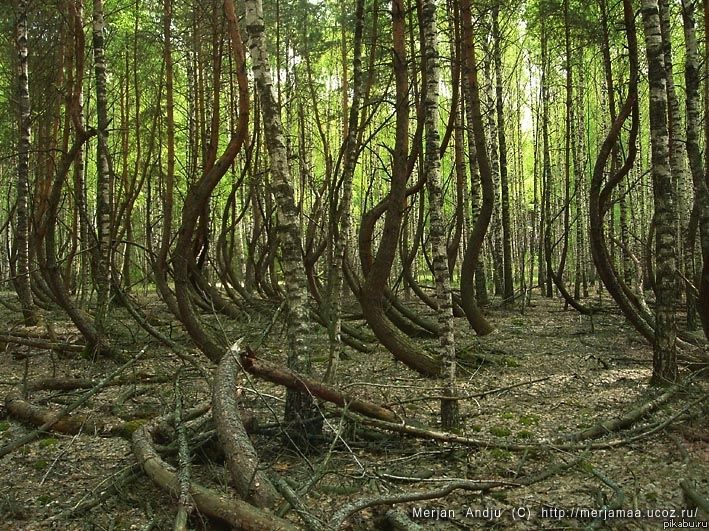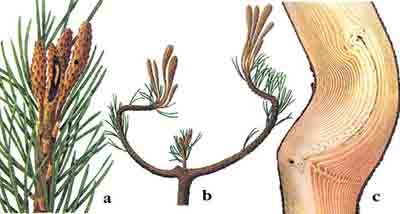The dancing (drunk) forest - forest with curved and tilted (in one or in different directions) the trunks of trees.
Photos of the "Dancing forest" in Curonian Spit national Park in Kaliningrad region
This phenomenon is known from ancient times has been inextricably linked with the stories about "bad places", later – "places of power" and later anomalous zones. How these places can be called abnormal or bad, we will try to understand during this article. To begin, consider the basic features and the geography of the manifestation of this phenomenon.
The main features of the phenomenon of the "dancing forest"
The phenomenon can manifest itself as some relatively large forest area and a few isolated trees.
The trees can grow at an angle, can be bent ring, fancy curved or tilted. With this arrangement, a bending in space for most of the trees can be chaotic or orderly (tubes or bending in one direction, from the center of the circle, etc.).
The manifestation of the phenomenon at the birches and pines
The phenomenon occurs mainly on pines and birches, while in the same area, he can touch one tree and not touch the other.
The geography of the phenomenon
The best-known manifestations of the phenomenon are:
- The national Park "Curonian spit"
- The national Park Burabay grove near lake Borovoe
- A drunken forest in Ivanovo lakes.
- The forest trolls in Denmark.
And about 8 seats that do not possess such reputation. These areas are often called "Anomalous zone – Dancing forest", regardless of location.
But in fact the phenomenon of the dancing forest is not so rare: such clearings are found in many forests and parks, sometimes these changes affected and separately standing trees.
Now you need to understand the causes of this phenomenon.
Hypothesis
There are 2 types of hypotheses to explain this phenomenon: the mystical and the realistic.
Mystical hypotheses:
- glade is a place of negative or positive energy (places of power);
- places of UFO landing;
- the curvature of time and space (gates to other worlds, etc.)
Realistic hypothesis:
- deformation and displacement of soil during tree growth;
Drunken forest formed by thawing permafrost. Dahurian Larch. Evenk Autonomous Okrug
- the effects of constant strong winds blowing in one direction;
- congenital hereditary or acquired and inherited genetic changes;
- pine plantations are damaged by caterpillars of butterflies of the genus tortrix moths (wintering pobegovyh) that eat the developing apical and lateral buds of the tree, resulting in the escape curves;
a — caterpillar devours the kidney; b — lyrate growth as a result of the loss of the apical Bud; C — deformation of pine growth after the destruction of the apical Bud.
At the outbreak of mass reproduction the larvae hibernating pobegovyh can destroy almost half of the third apical and lateral buds. The loss of the apical Bud it replaces one of the lateral buds, as a result, the crown is curved and takes the shape of a lyre or a bayonet. At strong damage of a large number of kidneys appear nest-shaped form of the crown, as a result of years of repeated infection on the tops arise globular clusters of short shoots.
- other options of impact on trees of viruses and pests;
- the impact of floods or rains;
- exposure to chemicals or radiation;
- damage to trees by lightning;
- the trees are bent after the explosion (for example, military explosive).
Conclusion
Based on the foregoing, we can conclude that one of the reasons all the cases, no. However, there are many hypotheses to explain the phenomenon and causes of the curvature of the tree trunks should look at their basis in individual cases your.
For example, Rhyacionia buoliana (Pobegovyh wintering) favors only some species of conifers. This explains why in some cases suffer only pine, but, for example, birch remain completely untouched. And in the case of "Dancing birch trees" on the shore of lake Borovoye cause is considered to be the heavy snow and strong winds.
As for the mystical stories associated with this phenomenon, in some cases, these places really should be afraid, because the curvature of the trunks of trees may indicate the presence of swamps, the susceptibility of soil to slide on the slope or the like causes deformation and displacement of the soil that affect growth.
Translated by «Yandex.Translator»
Log in or register to post comments







